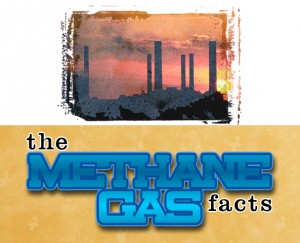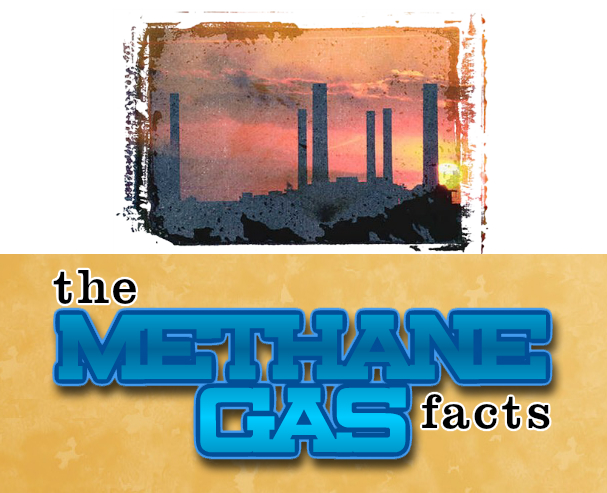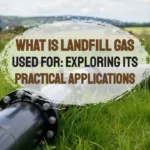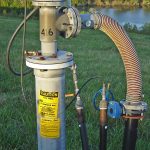 Methane Gas Facts 1. Methane comprises about 50% of landfill gas, and is the most reduced organic molecule. In other words, no further conversions to simpler organic molecules are possible once methane has been produced. It is produced as an end product of anaerobic metabolism. For the first of our Methane Gas Facts, let us look at a simple conversion reaction producing methane.
Methane Gas Facts 1. Methane comprises about 50% of landfill gas, and is the most reduced organic molecule. In other words, no further conversions to simpler organic molecules are possible once methane has been produced. It is produced as an end product of anaerobic metabolism. For the first of our Methane Gas Facts, let us look at a simple conversion reaction producing methane.
The Methane Reaction
 |
This is one of the most important reactions characteristic of anaerobic processes. Hence the production of methane can be used as a test for the anaerobic biodegradability of a test substance.
Methane Gas Facts 2. Methane is a short-lived Greenhouse Gas (GHG) with an atmospheric lifetime of approximately 12 years compared to over 100 years for carbon dioxide.
Gas Facts 3. Methane is 23 times more potent as a GHG, or over 80 times depending on how you look at it, kilogram for kilogram, than carbon dioxide. The balance of the input rate and the removal rate determines atmospheric concentrations of GHG.
Gas Facts 4. There will be a greater impact by concentrating on methane in the medium-term because it is short lived in the atmosphere and has a high global warming potential (GWP).
Gas Facts 5. Some 60 percent of methane emissions come from anthropogenic sources, with around 40 percent from natural sources.
We hope that this quick primer on this gas has helped you.
The Basic Processes Of Waste Decomposition
First, it is necessary to explain briefly the microbiological and chemical processes which give rise to landfill methane gas and leachate within a domestic waste landfill, during and beyond the active life of the site.
Probably the most widely-reproduced graph in the field of landfill science is that proposed as long ago as 1973 by Farquhar and Rovers, showing the generalised changes in the composition of landfill methane gas with time. (To be added.)
There are three major phases in the decomposition of domestic wastes, summarised below:
Phase 1: Aerobic decomposition rapidly (typically in less than a month) uses up oxygen which is present within the wastes.
Phase 2: Anaerobic and facultative organisms (acetogenic bacteria) hydrolyse and ferment cellulose and other putrescible materials, producing simpler, soluble compounds such as volatile fatty acids (with a high biochemical oxygen demand (BOD) value) and ammonia.
Phase 3: More sensitive and slower-growing methanogenic bacteria gradually become established and start to consume simple organic compounds, producing a mixture of carbon dioxide and methane (plus various trace constituents) which is released as landfill gas.
Phase 1 is short, perhaps lasting only a few days or weeks. However, it may persist for long periods, producing significant quantities of cartoon dioxide, in shallow (10 000 mg/l); and high ratios of BOD:COD (commonly 0.7 or greater) indicating that a high proportion of the soluble organic materials are readily degradable. Other typical characteristics of the leachate are acidic pH values (typically 5 or 6), strong unpleasant smells and high concentrations of ammonia (often 500-1 000 mg/l) are to be expected. The aggressive chemical nature of such leachate assists in the dissolution of other components of wastes, so leachates can contain high levels of iron, manganese, zinc, calcium and magnesium. Gas production consists mainly of carbon dioxide with lesser quantities of methane and hydrogen.
Phase 3, the methanogenic stage commences as the available chemically bound oxygen molecules in the waste mass are fully consumed.
The landfill gas expert becomes familiar in the odour of the methane gas and can usually tell when methanogenicity is present, due to changes in smell, and with the onset of the characteristic methanogenic “landfill odour”.
Trace Gases in Landfill Gas from a Typical United Kingdom Municipal Solid Waste Landfill
Trace gases in UK landfill gas include a mix of VOCs, hydrogen sulfide, nitrogen, and others. These gases arise from the breakdown of organic waste and microbial actions. Over 500 trace components have been identified, including hydrogen sulfide, vinyl chloride, carbon disulfide, and BTEX compounds…
Is Your Landfill Site Ready? Assessing When to Install Gas Flares & Landfill EfW Systems
The urgency for compliance with the COP29 methane pledge means waste managers must act immediately. Gas flares are mandatory for low volumes, while EfW systems transform hazards into valuable energy. Install EfW when LFG is significant and steady to secure compliance and profits ahead of deadlines…
What is Landfill Gas Used for: Exploring Its Practical Applications
In a quiet corner of Yorkshire, a local council recently transformed a decades-old rubbish site into an unexpected power source. Beneath the grassy mounds lay a hidden network of pipes capturing invisible emissions from rotting food scraps and garden clippings. This methane-rich mixture now fuels nearby factories and heats over 2,000 homes – turning yesterday’s […]
US Landfill Gas Resources: A Booming Green Energy Sector
Untapped U.S. Landfill Gas Resources are an Opportunity for Green Investment The American landfill gas (LFG) sector has seen a big change in recent years. It's now a key player in the country's biogas world. Even though it's only 23% of over 2,500 biogas systems now installed nationwide, it captures 72% of all biogas by […]








